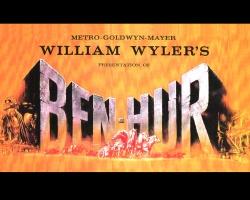In the beginning, there was light. And soon after, it seems, there were movies. And with movies came movie posters–the “heralds” that drew people into movie theaters, particularly during the Golden Age of Hollywood: the 1920s through 1950s. This was a time “when fantasy architecture made its visitors feel as though they were entering into a sacred space,” says the Rev. Michael Morris, a Dominican priest, film scholar and avid movie poster collector.
But the posters–some of them as monumentally designed as the films they were advertising–could be miniature masterpieces in their own right. And, in fact, some were superior to the films showing inside the theaters.
“The creators of some vintage and modern biblical film posters drew on the gravitas of masterpieces of biblical painting and sculpture,” said Paul Tabor, the director of exhibitions for the Museum of Biblical Art in New York, which is exhibiting “Reel Religion: A Century of the Bible and Film,” through May 17.
The exhibition features about 80 posters culled from Morris’ collection and from that of Mary Strauss, co-owner of the historic Fox Theatre in St. Louis. It also includes such curiosities as the mauve cape Charlton Heston wore in “Ben-Hur” and the chest plate worn by Yul Brynner in Cecil B. DeMille’s “The Ten Commandments.”
Also featured as part of the exhibition is a 28-page essay by Morris, a professor of religion and the arts at the Dominican School of Philosophy & Theology in Berkeley.
In the essay, as well as at a recent lecture at the museum, Morris said most Americans still associated biblical films with the “sword and sandal” era of “Ben-Hur” (1959), “The Ten Commandments” (1956) and “The Robe” (1953). Biblical stories were treated to grand, elaborate Hollywood treatment, partly because of the advent of wide-screen Cinemascope.
Almost by necessity, the movie posters advertising the films followed suit, he noted.
“Even the posters began to look monumental with the very letters of the title taking on an architectonic profundity as in ‘Ben-Hur’ and ‘King of Kings,’ ” Morris said. “No matter what the language, the characters and the letters could be manipulated to reflect the magnificence of the film.”
Still, the exhibition makes clear that movie posters have to be seen as works of art and craftsmanship that can stand on their own.




